Although the ROCOR’s history begins in the immediate aftermath of the Russian Revolution and Civil War, there are many parishes and communities that pre-date the main White emigres. These parishes include churches established by the Tsar in popular European resorts, embassy churches, and communities formed by the first Russian emigres to arrive in America, most of which were former Greek Catholic (Uniates) parishes that later formed the nucleus of what became the Orthodox Church in America. One such parish from the latter group is Saint John the Baptist Cathedral in Mayfield, Pennsylvania. Deacon Michael Pavuk, a cleric of the parish, lifelong member of the Mayfield community, and Director of Development at Holy Trinity Seminary, explains how this community of 19th century Greek Catholic immigrants ended up as a cathedral in the ROCOR and how its fascinating history has helped to form a parish community that is unique to the typical ROCOR experience. Interestingly, this “old emigre” parish joined the ROCOR almost simultaneously with the Russian priestless community that has existed in Erie, PA from the late 1800s.
So, to get started, can you give me a brief overview of the affiliation of the Mayfield parish prior to it joining ROCOR?
The earliest Slavic people came here from Austro-Hungarian empires in the late 1870s to early 1880s and the first thing they did was form the Brotherhood of Saint John the Baptist. They chose him as the patronal saint for a burial society. They realized that before they had the money to actually form a parish and build a church, they needed to be able to bury their faithful. The church actually traces its founding to 1891, but that’s probably not accurate. The founding probably dates back to the 1880s, because at that time they were a Greek Catholic parish, and were being served by priests, using an inactive Baptist church across town that no longer even exists. Then they were serving in a home behind the parish for a few years before they were able to buy the land and build the first church building in 1891.
Nevertheless, the church was Greek Catholic until 1902 and was one of the primary parishes on the eastern seaboard and in northeastern Pennsylvania that Saint Alexis Toth, who had, in the second half of the nineteenth century, already come to the fold of the Orthodox Church and was on a personal mission to bring as many Uniates back to Orthodoxy as he could, sought to bring into the Orthodox Church. In 1902 the church was accepted into the Orthodox Church and Saint Alexis Toth and Saint Alexander Horovitsky, who was martyred by the Bolsheviks in the Soviet Union in the 1930s, were the two priests that served the first Orthodox liturgy at the parish. Although the priest at the time, Father Theophan Oboskevitch, was actually instrumental in this, however, he did not join the people in coming to Orthodoxy. In other words, he didn’t prevent them but actually assisted them, even though he himself didn’t follow them.
From 1902 until after the Russian Revolution, we were affiliated with the Russian mission in America. Saint Tikhon of Moscow was the bishop from 1898 and until 1907 when he was recalled to Russia. He actually called and chaired the first All-American Sobor at the Mayfield parish on 20th-23rd February 1907. After 1920, there was really no distinction made here by the faithful between the American Metropolia and the Church Abroad. I don’t think they even understood the distinction. In 1930, we moved the old church out onto the street and constructed the new church. It took three years for it to be consecrated, and the consecrating hierarch was Archbishop Apollinary (Koshevoi), who is buried here in Jordanville. Bear in mind, when this monastery was founded in 1930, it was founded as the second monastery of the American Metropolia. Archbishop Apollinary himself, as well as the Metropolia, was connected to the Church Abroad at the time, so the consecrating document for the new Mayfield church in 1933 lists Metropolitan Anthony (Khrapovitsky), First Hierarch of the Russian Orthodox Church Outside Russia, as the spiritual superior. Essentially, in the 1930s, our parish had concrete documentation of affiliation with the Russian Church Abroad, through Bishop Adam (Filipovsky), who actually consecrated the church building, although I have my doubts that the people in the parish understood that distinction.
Nevertheless, it was after 1946 and the Cleveland Sobor that lines were drawn and, bear in mind, in those years the Metropolia and the Church Abroad both served in Slavonic, both were on the Old Calendar, so to local people in the parish who were not a part of the Russian emigration after the revolution, there was probably no distinction between a “White Church” and a “Red Church” in the Soviet Union, or a White Church in the emigration and the Metropolia. In those years after 1946, the Metropolia had an affiliation with no one. In 1951, that was when our people were formally approached and decided to join the American Metropolia. The other parishes in the area were in a similar circumstance, Saint Tikhon’s Monastery had already landed squarely in the Metropolia and Holy Trinity Monastery was already squarely in the Church Abroad, so the distinction was clear and our people, because of the proximity to Saint Tikhon’s and their being involved in its foundation, just decided to join the Metropolia. Essentially, that was the first time the church had an official affiliation with the Metropolia, which lasted until 1982.
So, you’ve taken us up to the 1980s. What were the circumstances regarding the parish’s reception into ROCOR and what was the process like?
This took place on August 29th, 1982. What happened was that Archbishop Cyprian (Borishevich) was the rector of Saint Tikhon’s Seminary and deputy abbot of the monastery, and he was a traditionally-minded bishop. It was clear that he was the one slamming the brakes on the OCA making some modernist changes, most notably changing the calendar from the Julian to the so-called Revised Julian. He died on December 14th 1980 and, not long after he passed away, his vicar bishop was elected and installed the following May as Bishop of Philadelphia. It was apparent that the last barrier to the Synod of Bishops pushing this through was basically gone. So, sure enough, at their fall meeting in 1981, they voted to adopt the Revised Julian calendar in all their dioceses. Ironically, Eastern Pennsylvania already had parishes that had been founded in the 1950s and 1960s and were permitted to start on the New Calendar, so every diocese already had a conglomeration of old and new calendar parishes. That was what precipitated the problem.
In the spring of 1982, my late father Thomas (d. 2002), who had taught at Saint Tikhon’s Seminary in the 1970s, was starosta of the parish and began holding meetings with the people to determine if they wanted to accept the calendar change and, if not, what they were going to do. The interesting thing was that we had a set of proposed bylaws that had been given to us by the OCA which completely changed the complexion of property ownership and stated that the property was owned by the diocese, which is a very Roman Catholic model, but was also the model in the Russian Church when the Russian imperial government was paying for the building of churches. The Mayfield people had built the buildings and acquired the property on their own and were not about to, especially with their history of trying to discern who the real traditional Orthodox bishop was, hand over their property to a diocese or bishop of any type. So, the meetings were taking place and the perception by the OCA bishop was that the bylaws had already been changed and the diocese now owned the property, but the truth is that they were never voted on or ratified by the parish, so all through the spring of 1982, we held this series of meetings that Bishop Herman objected to, but my father went on having them anyway, up to being summoned to the bishop’s office and being threatened with suspension. My father stood his ground and said that he had taken an oath to Almighty God, not to any diocese, and as such was also beholden to the people of the parish as starosta and was going to continue to meet and discern the will of the people. Ultimately, we had a meeting on August 22, 1982 and the parish voted 151-3 to leave the OCA. The parish then drafted a letter.
Prior to this, the parish had already had meetings with the late Bishop Gregory (Grabbe) and Archpriest Vladimir Shishkov to lay the groundwork, so that we knew that the road was paved, that the parish could make this transition, and that the Synod would accept us and, concurrent with that, our own parish priest was willing and interested in coming along with the parish to the Church Abroad. He actually purposely took a vacation during this week so that he wasn’t involved in this, because we knew that the bishop could suspend him for disobedience, so he removed himself from the circumstance. The parish voted and then he petitioned the Church Abroad to receive him. In those days, no one would give canonical release for anyone to leave the OCA for the Church Abroad.
There was then six years of court cases until the issue was finally settled in 1988 after the OCA filed a series of appeals and lost everyone, largely because the church was incorporated in 1907 as a non-profit parish corporation owned by the dues-paying members. We were able to prove that we were under the Church Abroad in the 1930s when the building was built but also that we joined the Metropolia by a vote in 1951 in the first place. The OCA wanted to turn it into a history lesson about which church was more legitimate, or which was the successor to the Russian American mission of the 1800s, but the judge understood that this was a property dispute and it was not his place, or that of a civil court, to decide which branch of the Russian Orthodox Church had legitimacy; his decision was who owned the property (compare this with the Sea Cliff’s litigation, over the ownership of the church there, which, in fact turned into a history lesson – ROCOR Studies).
When the parish joined the ROCOR there was the struggle against ecumenism and the new calendar, the hostility towards the Moscow Patriarchate, and the status quo of the Boston monastery. How did the parish take to the ROCOR ideology of that period? Did the people pay much attention to this?
Most of the parishioners did not; for most of the parishioners, the only thing this whole transition was about, quite frankly, was the calendar in general and, most specifically, the date of Christmas. My point is that if you had said to any of our parishioners in the early 1980s if they would go to court and spend money and fight to change jurisdictions over whether you celebrated Transfiguration on August 6th or 19th, they wouldn’t care less. Most people don’t realize that the calendar affects all the fixed feasts of the Church and what clouds the issue is that we celebrate Pascha on the same day as the New Calendarists, so it makes it difficult to understand.
All that being said, there were people, myself included, who were starting to inform ourselves about what the difference was because, quite frankly, I realized that the connection between the Metropolia and the Church Abroad, at least until 1946, was different than what I thought; there was a lot of connections. Beyond that, up until 1970, the Church Abroad was looking to re-establish a connection with the Metropolia for the specific purpose of preventing them from accepting the tomos from the Moscow Patriarchate. I never understood that as a kid growing up and when I heard about the Church Abroad, it was always referred to as the Russian Orthodox Church in Exile, which was something of a derogatory term. It was always framed as being very traditional, no English, the priests have long beards, and the services are longer, but the term ‘in Exile’ was meant as a derogatory term.
In the early 1980s, when we came to the Church Abroad, everyone comes with baggage of what they thought was the truth, we had to open our eyes and realize if we were understanding the real truth or not. What I came to realize is that, first of all, for our people, ecumenism, sergianism, none of those isms mattered to any of our people in the beginning; that was not the reason that they came. It wasn’t the tomos or even being connected to the Moscow Patriarchate – in fact, a lot of parishioners wanted to know why we didn’t become a patriarchal parish. The Tomos prevented any parish of reverting back to the Patriarchate after 1970.
Our people probably would have felt more comfortable in the Patriarchal Church in those years, just from the perspective that those parishes looked like ours: they were the first emigration, from before the Russian Revolution, the parishes, for better or worse, had pews, which was a Uniate influence, and they were introducing English, so the complexion of our parish was very different to the typical ROCOR parish and many people who came to visit would think, “Wow, this is a really beautiful and historical church, but why do you have these pews, why is there so much English, and why are the services shorter?” Since then, we’ve lengthened and added to the divine services, but the truth is, to this day, if you come to the Mayfield parish, our service are longer and more complete than the average OCA parish, but shorter than the average ROCOR parish. We’re still in this in-between world.
I came to the Russian Church Abroad drinking the American historical Kool-Aid about the Royal Family and when they were glorified by ROCOR the year before we came, I couldn’t understand why. Now, having read real histories about their lives and their years of imprisonment and deaths, I completely understand and have changed my view, but in the year that we came, glorifying the Royal Family and being in opposition to the Church in Russia was foreign to our people. In fact, when we were in the Metropolia, we used to belong to a fraternal organization called the Federated Russian Orthodox Clubs (FROC) and the OCA and the Patriarchal Parishes all had chapters in this, even before 1970. We actually had a close affiliation with Patriarchal parishes. We were neighboring OCA and Patriarchal parishes physically – there were no neighboring ROCOR parishes – and we were more similar to them, so coming to the Church Abroad was an adjustment. We didn’t really fit in and were something like a red-haired stepchild in many ways!
You brought up an issue of the identity of the parish vis a vis the ‘Zarubezhnyie’ parishes. How does the parish community view itself? Does it still hold onto the Russianness like many of the ROCOR parishes?
That’s an interesting question. In terms of someone coming from a ROCOR parish, who is an ethnic Russian, they would look at the parish and see it as very Americanised compared to their experience. You have to remember that, all the way back to the founding of the parish at the end of the 19th century, there was a huge Americanisation movement here in the United States. This is a big reason why – I’m the second generation on my father’s side and the third generation on my mother’s side – I don’t speak much Russian.
Although the parish moved to Orthodoxy from the Unia, in terms of the practice of the faith, if you look at pictures of my parish a hundred years ago, the priests were clean-shaven and were wearing Roman collars and suits. It wasn’t that they weren’t Orthodox and that Orthodoxy wasn’t dear to them, but they were Americanised all the way back then. It has to do with why we didn’t learn the language. Yet – although there aren’t a lot of Russian speakers, with most of our parish being Galicians, Lemkos, or Rusyn – our people are absolutely Eastern European Slavs. They came from the Austro-Hungarian Empire, the area near the Polish border, sometimes in modern-day Poland or Slovakia, so they’re definitely Eastern Europeans, but they’re like people without a nation. They’re not Polish, Ukrainian, Slovak, nor Russian, but, interestingly, because they affiliated with the Russian Orthodox Church as far back as 1902, our people never called themselves Rusyn, Galician, or Lemko – I learned this by studying our history – but consider themselves Russian. If you ask any of the old people in Mayfield what their ethnic background is, they’ll tell you that they are Russian. They were proud of their affiliation with the Russian Empire.
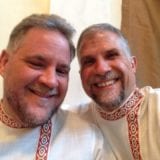 Ironically, to themselves, they consider themselves Russians, but to an outsider, they don’t look or seem like Russians. Yet, until 1970, our choir sang everything in Slavonic, but very few people in the church in those days spoke any Eastern European dialect. All of these people came from what was the Austro-Hungarian Empire, but they are Slavs. To them, they are Russians and they like hearing Church Slavonic, even if they can’t understand most of it! Of course, all the familiar prayers and hymns are known to the people, but if you read the Gospel or Epistle in Slavonic, or preach in Russian, they’re not going to know what they mean, although the history is precious to them. It’s a very ironic kind of situation and I didn’t see all this clearly until I started to travel outside of my own parish and come to other communities to see what they were like, what kind of people they were comprised of, and how people saw themselves.
Ironically, to themselves, they consider themselves Russians, but to an outsider, they don’t look or seem like Russians. Yet, until 1970, our choir sang everything in Slavonic, but very few people in the church in those days spoke any Eastern European dialect. All of these people came from what was the Austro-Hungarian Empire, but they are Slavs. To them, they are Russians and they like hearing Church Slavonic, even if they can’t understand most of it! Of course, all the familiar prayers and hymns are known to the people, but if you read the Gospel or Epistle in Slavonic, or preach in Russian, they’re not going to know what they mean, although the history is precious to them. It’s a very ironic kind of situation and I didn’t see all this clearly until I started to travel outside of my own parish and come to other communities to see what they were like, what kind of people they were comprised of, and how people saw themselves.
I guess that my ultimate point is that the Mayfield people see themselves as more Russian and Slavic and are proud to call the church Saint John the Baptist Russian Orthodox Cathedral. That’s actually another reason why we left the OCA; if there’s any reason other than the calendar, it had to do with the perception that English was being forced on parishes, almost against their will, and the word “Russian” was being removed from the title of the parish. Even though we were multiple generations in America and clearly Americanised, our people didn’t want to lose that identity.
Another significant thing that I want to point out was that my parish in particular and, quite frankly, a lot of the parishes that were part of the pre-World War One immigration in the United States, whether they were in the Greek Catholic Church and remained there, or they moved to the Orthodox Church and are now still in the OCA or the Moscow Patriarchate; nevertheless these people – during very difficult times – mostly eventually built really good solid church buildings that they could take pride in. Even if they had to tear down the original church and reconstruct it as we did in Mayfield after ~40 years (1891-1930).
With most of the “typical ROCOR parishes” that were part of the first Russian immigration between the Russian revolution and World War II, many of whom ended finally up in the USA between the late 1940s and 1950s, although Lakewood is an exception, as well as St Vladimir’s in Jackson and the cathedral in San Francisco, nevertheless many of the other parishes seem to still have a refugee mentality in terms of the fact that many decades have passed and the people are obviously staying here in the West, they’ve had good jobs and made good livings, but still – the actual churches are tiny and don’t look as though the community took pride in the building when they built it in the first place, nor have enough pride in taking it down and reconstructing a more significant church thereafter.
I will sum it up by saying that my immigration had very little in terms of financial resources, and yet during the great depression, having a nice, beautiful church was their main priority, while they lived in tiny houses. The ROCOR immigration ended up doing quite well for themselves financially in many cases; having nice houses, nice cars, and comfortable lives, but their churches are still pretty tiny and insignificant. Just an observation. It might be an overgeneralization but that’s been my experience for the most part. This even ties in to what they do (or don’t) pay their priest – many have to work as opposed to having their priesthood be their full-time ministry – this also includes the choir director, and the homes that they do or don’t provide for these servants of the church as well.
How did the other ROCOR parishes view the Mayfield parish as it began its integration into ROCOR?
In terms of integrating with ROCOR, in the very early days we really made an effort to try and connect. I won’t use the word “fit in,” because it’s not like all of a sudden our clergy started to grow their beards longer, ripped the pews out, and stopped using English, because there was very little English in ROCOR then. What we did do was lengthen the services, changed the look of some of the inside of the church, we brought in analogion, we got rid of the glass votive candles and brought in beeswax candles. We tried to move back to being a little more traditional, as ROCOR parishes are.
When we would visit other places, because I was not a Russian speaker, I would be automatically dubbed a convert. In ROCOR, people could not understand that someone who had been baptized as an infant in a Russian parish and been Orthodox their entire life could not speak Russian. They had no connection to the idea of pre-World War One emigration and Americanisation over the decades. So, I was viewed as a convert, no matter what I said. We’re all converts; I was just a convert at forty days! In that respect, it was hard to fit in. I came to Jordanville for one of the first Saint Herman conferences and brought kids from the parish, so we tried to integrate.
We hosted a conference in 1983 and there were people from ROCOR parishes from all over the north east. It was a huge conference. When people first came, they be thinking about what the pews were doing there, it was an immediate turn off for people. The English some people loved it, some didn’t care for it. I had a lot of people that came to our parish for the first time and, since we have always been blessed with a good choir, it was their first experience when the liturgy was served well in English with good singing and reading. They had a whole new and better perception of what English could potentially be like.
Even if a lot of people were a bit suspicious about our parish “poisoning the ethos of ROCOR”, there were certain things that we brought to the table that were of benefit. I’m not going to make excuses for us still having pews in the parish, and I’m certainly not going to make excuses for using a lot of English, but we probably have more Slavonic on a Sunday than you would think. Our elder generations learned to pray in this language, so it’s necessary to maintain it out of respect to them.
Emigrating into ROCOR was a challenge because we were one of the first parishes that joined ROCOR with all this baggage. People were usually part of the White emigration and were accustomed to all the ROCOR traditions and service lengths, or the came in as converts and, in those days, it seemed to me that, if you converted, you didn’t just become Orthodox, but became Russian. You converted to become Russodox; if you wanted to fit in, you had to do it all. You had to learn the language and embrace the whole culture and ethos, but we knew that to move the parish to that whole ethos would be impossible.
Last question: after the 2007 reunification with the Moscow Patriarchate, how have relations developed with the OCA, after more than thirty years apart?
That’s a great question and I’ll say that, to this day, eleven years after the reunification, still a work in progress. I’ll answer the question by saying this: in the 1960s, 70s, and early 80s we had very strong connections with Saint Tikhon’s monastery, and I had family members who were founding members of the community. 1982 was like falling off a cliff. The relationship was not only non-existent, but it was bitter and vicious. People in the OCA were told to call Father John “Mr. Sorochka”, even though we was never deposed from the priesthood. He was suspended by them. People were forbidden to come to the church from Saint Tikhon’s; there were generations of seminarians that never stepped foot in the Mayfield church because they were literally forbidden to come. ROCOR priests couldn’t bury in OCA cemeteries and vice versa. It was very unpleasant.
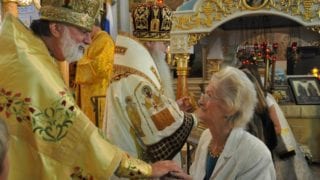
In font Fr. John Sorochka, the dean of the parish, after the service with Bishop George (Shaefer), at that time of Mayfield. Fr. Michael’s mother in law Tatiana F. Zonta is kissing the cross
The idea that it is pleasing for brethren to dwell together in unity, well, we were about as dis-unified with our Orthodox brothers and sisters as possible. It was sad. It should have been that we chose to go back to the Church Abroad and stay on the old calendar, but there’s plenty of churches to choose from, so why can’t we all get along like brothers and sisters? Well, it didn’t work out like that. For twenty-five years it was pretty bitter.
The reunification not only healed the wound in the Russian Church, but I understood that day in Moscow when I was standing there watching Metropolitan Laurus and Patriarch Alexey sign the act of canonical communion, that the ripple effect of this could potentially be felt all the way back to my home valley. It took a while, but over the next couple of years, there was a palpable sense of healing. I used to go to Saint Tikhon’s in the years before that and people either never knew who I was, or, if they knew who I was, they wouldn’t talk to me. After the reunification, those feelings started to dissipate and new relationships were formed, even among hierarchs, even to the point where people from other parishes started visiting the Mayfield parish, OCA clergy were invited for feast days and vice versa, we were invited to serve and come to Saint Tikhon’s for Memorial Day.
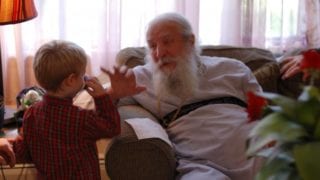
This photo well captures Metropolitan Laurus’ interaction with children. Here he is in Mayfield with John Pavuk
One of the most exciting days was in March 2010, when our parish hosted the Lenten clergy conference for the Eastern American diocese and Saint Tikhon’s hosted the Eastern Pennsylvania diocesan conference. I think it was on purpose and they actually invited our delegation from ROCOR – Metropolitan Hilarion, Bishop George, and Bishop Jerome – to Saint Tikhon’s. So we went and, when I stood there, they actually invited Metropolitan Hilarion, not only to visit, but to be received formally in a church. He got out and put on his blue mantle and klobuk and the abbot presented him with the cross. All the OCA and ROCOR clergy venerated the cross as if he was entering to start the liturgy. He went up and venerated the icons and the relics of Saint Alexis Toth. He turned around and addressed us and he mentioned the same thing, about brethren dwelling together in unity. I was ready to cry, because I realized that this was the first time, probably since 1946 or before, that a ROCOR hierarch was officially welcomed in this church. It was beautiful.
There are some people in ROCOR that still have a sour taste for the OCA, and vice versa, but for the most part I see priests concelebrating: in Simpson, where there are the two dueling Saint Basil churches, the two priests there are now such good friends that, when one has a new calendar feast, the old calendar priest goes and serves as his altar boy if there’s no kids around, and vice versa. They’re helping each other.
Of course, we’re still opposed to the negative aspects of ecumenism, we’re opposed to the new calendar, we’re part of the Russian Church, and we have definite things that we’re going to stand on in regards to the circumstances in Ukraine, but the point is that, even if you have differences of opinion on all these things, there’s no reason why you can’t respect one another as fellow Orthodox Christians. I have seen quantum leaps in that direction, even if some people still have a hard time softening their hearts. I have seen it from bishops, clergy, and faithful. Of course, there might be setbacks here and there, but even when not everyone is convinced and there are still some suspicions and concerns, but we are still united and there is tremendous forward progress.
The only thing that is going to help fully heal the problems that still exist here and there is the passage of time and the grace of the good Lord.
Thank you very much, Father Michael, for this edifying interview.
Conducted by Rasaphor Monk Angelos (Stanway) as part of the fulfillment of the requirements of the HTS graduate course ROCOR History and Identity-723

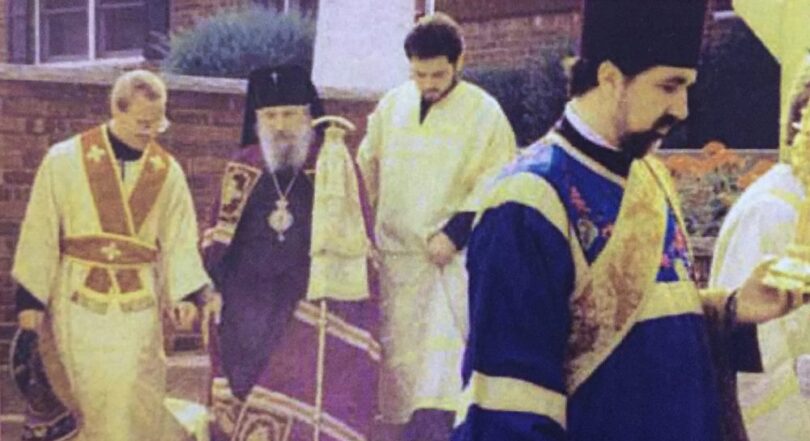
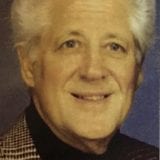
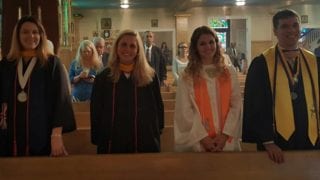










This is a very interesting article that covers a lot of material dealing with both religious as well as ethnic topics.
It’s interesting to note that the majority of the monks who founded Jordanville came from what is now Slovakia and not Russia, yet the feel of Jordanville is very Russian. If I am not mistaken , Bishop Luke , the current head of thr Monastery has familial ties to Lemkovyna in Poland and not Russia.